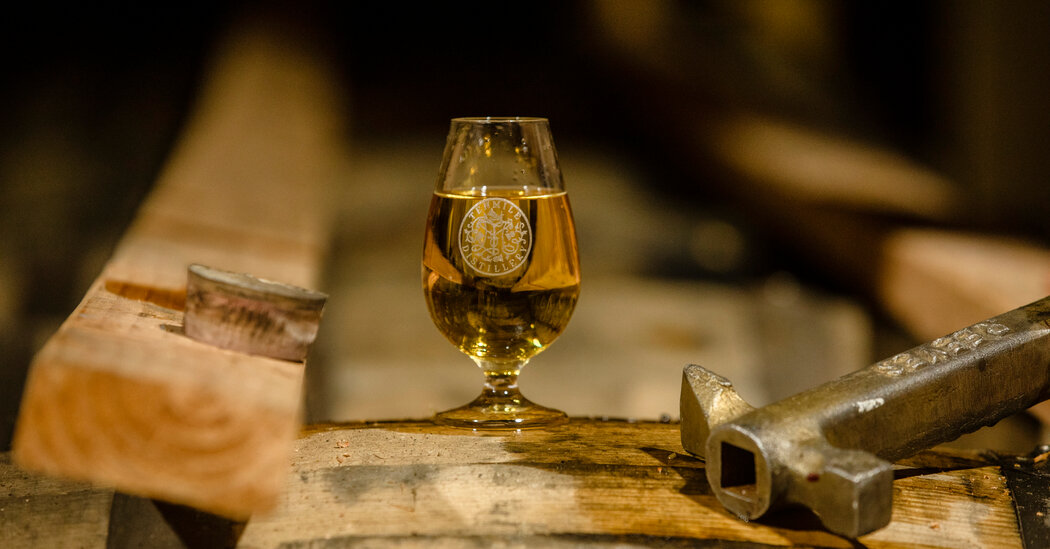
American Single Malt Whiskey, a Freewheeling Cousin of Scotch, Comes of Age
WASSAIC, N.Y. — The Tenmile Distillery makes single malt whiskey, and only single malt whiskey. So it’s fitting that a visit to this facility in Dutchess County feels like being transported to the Scottish Highlands.
Tucked into a narrow valley — the Scottish would call it a glen — about 90 miles north of New York City, Tenmile’s buildings are whitewashed and low-slung. Inside sit two swan-necked copper stills made by Forsyths, the same company that outfits storied Scottish distilleries like Glenfiddich and Glenlivet.
None of this is coincidental. Tenmile aspires to produce a whiskey that in its aroma, palate and texture closely approximates single malt Scotch, including its use of barrels that once held sherry, port or red wine. In Tenmile’s case those barrels come from Williams Selyem, the California winery that, like the distillery, is owned by John Dyson, a former New York state agriculture commissioner turned investor.
“I wanted to do the whole thing in the most traditional Scottish way possible,” said Mr. Dyson, right down to hiring a veteran Scotch distiller, Shane Fraser, to run production. The distillery’s first release, Little Rest, has just been bottled, and it has already sold half of its presale orders.
American single malt may sound like a contradiction in terms and a sin against the venerable traditions of Scottish whiskey making. But the style has been booming over the last decade, with a diversity that reflects the country’s sheer size and its wide variety of climates, traditions and agriculture.
In the coming months, the Tax and Trade Bureau, a part of the Treasury Department, will release an official definition of American single malt — the first new spirit category in many years and a recognition that a once-niche whiskey has entered the mainstream.
“It’s a necessary step given the critical mass that we have here, with over 200 distilleries making single malt whiskey in this country,” said Steve Hawley, who in 2016 co-founded the American Single Malt Whiskey Commission to push for the new definition. “That’s more than all of Scotland.”



Tenmile Distillery closely models itself after Scottish whiskey makers, down to its low-slung buildings and aging warehouses. Even its master distiller, Shane Fraser, had a long career in Scotland before coming to the United States.Credit…Lauren Lancaster for The New York Times
The proposed American definition is looser than Scotland’s famously rigid rules. Like Scotch, American single malt would have to be made at one distillery — hence “single” — using 100 percent malted barley. But while the Scottish version must be distilled on a pot still and aged for at least three years, neither requirement would exist in the United States.
Tradition (though not law) dictates that single malt Scotch be aged in used casks, usually bourbon barrels, but no such expectation exists for its American counterpart. That gives distilleries like Tenmile a wide range of tools to shape the whiskey’s flavor, especially compared with bourbon and rye, which by law have to be aged in new, charred oak barrels.
Since new or used barrels can be used, as soon as the unaged spirit goes in, “we’re able to start shaping the flavor profile however we want,” said Murphy Quint, the head distiller at Cedar Ridge, a distillery in Swisher, Iowa, that makes bourbon, rye and single malt.
One advantage of malted barley is that it’s more like a canvas than a color. Its soft, nuanced flavors allow distilleries to layer it with influences at every step of production, from the variety of yeast and barley, to the peat or other sources of smoke used to stop the seeds from germinating, to the type of barrel it ages in.
Such diversity has allowed for a variety of distillery house styles to emerge. Tenmile’s whiskey is fruity and elegant, not unlike the whiskeys made in the Speyside region of Scotland.

Tenmile’s whiskey has a light straw color and delicate aroma, similar to the Speyside whiskeys of Scotland.Credit…Lauren Lancaster for The New York Times
In contrast, at Westland, a distillery in Seattle, you’ll find no pretense about making anything resembling Scotch.
Westland’s master distiller, Matt Hofmann, draws inspiration from Pacific Northwest agriculture and culinary traditions. He uses brewer’s yeast instead of distiller’s yeast to ferment local varieties of barley, both of which tweak the whiskey’s flavor. Even some of the wood used to make Westland’s barrels is cut from a local species of oak, Quercus garryana.
“We can do this in a way that’s not a clone of Scotch,” Mr. Hofmann said. “Not that there’s anything wrong with Scotch. But it’s just like, what else is out there in an industry that’s 500 years old? For me, growing up here in the Pacific Northwest, it’s the ability to make a whiskey that is reflective of this place that I love.”
Mr. Quint takes yet another tack at Cedar Ridge. Barley is scarce in corn-dominated Iowa, so Mr. Hofmann’s local approach won’t work. Instead, Mr. Quint ages his whiskey in a wide variety of barrels, some of which once held port or red wine, then mixes and matches them in a 1,100-gallon vat, where the flavors meld to create a richly textured, nuanced final product.
“We pick a mark for a flavor profile that we’re hoping to hit at the very beginning, and we kind of guide it along the process to get it there,” he said.



Matt Hofmann, the master distiller at Westland, in Seattle, makes a single malt whiskey that is worlds away from the style’s Scottish roots.Credit…Meron Tekie Menghistab for The New York Times
Other approaches venture even further from single malt’s Caledonian roots. Whiskey Del Bac, a distillery in Tucson, Ariz., is one of several in the Southwest to use mesquite instead of the traditional peat to smoke its barley.
Both Long Island Spirits, in Baiting Hollow, N.Y., and Charbay Distillery, in Ukiah, Calif., employ commercial-grade beer as the base for their whiskeys. Long Island uses a barley wine to produce its Pine Barrens brand, while Charbay uses beers from the Bear Republic Brewery, including its Racer 5 I.P.A., to make a variety of single malts — though its most recent release, Lot One, a collaboration with the whiskey brand Wolves, was made from scratch.
The geographic diversity of the United States allows “a range of flavors that I haven’t seen in a single country with single malt or in American bourbons,” said Nora Ganley-Roper, whose company, Lost Lantern, buys barrels of whiskey from small distillers and bottles them under its own label, a widespread practice in Scotland that is only now gaining steam in the United States.
There is some concern that precisely because American single malt is still emerging, new federal rules might choke off innovation. Mr. Dyson, of Tenmile, already has whiskey aging in barrels made from wood species other than oak, species that would not be allowed under the new rules.
“Why, at an early stage, narrow the range or experimentation?” he asked.
It’s a fair point. But Mr. Hawley of the American Single Malt Whiskey Commission and others said the rules are broad enough to allow innovation while still aligning the style with single malts made in the rest of the world.
“Because of the nature of production, American single malt won’t ever have a fingerprint from a flavor standpoint,” he said. “It’s going to be so vastly different, which is what makes it interesting.”
Follow New York Times Cooking on Instagram, Facebook, YouTube, TikTok and Pinterest. Get regular updates from New York Times Cooking, with recipe suggestions, cooking tips and shopping advice.




